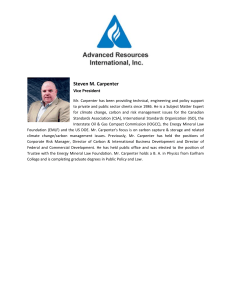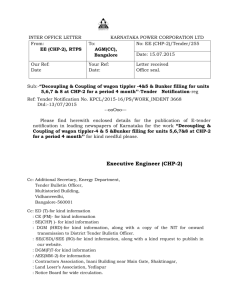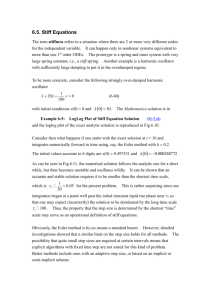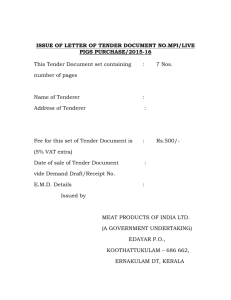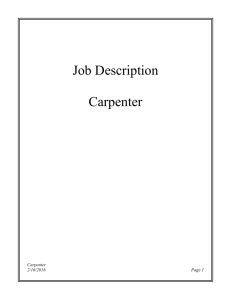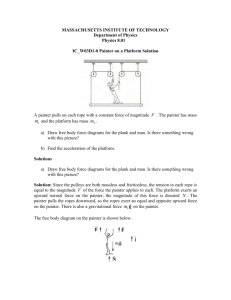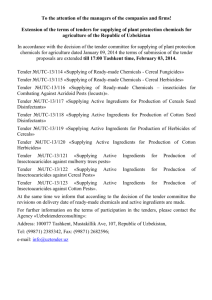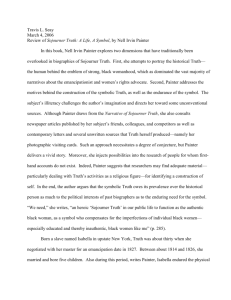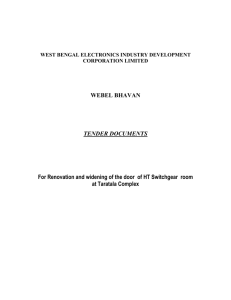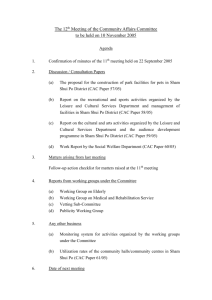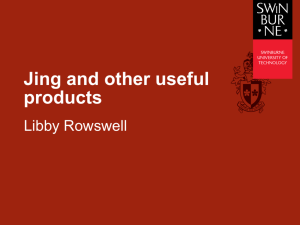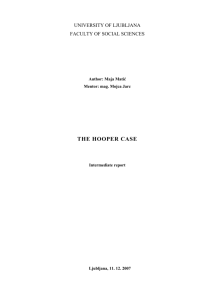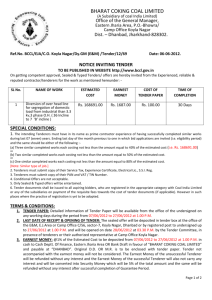Daoism in the West: Art and Architecture
advertisement
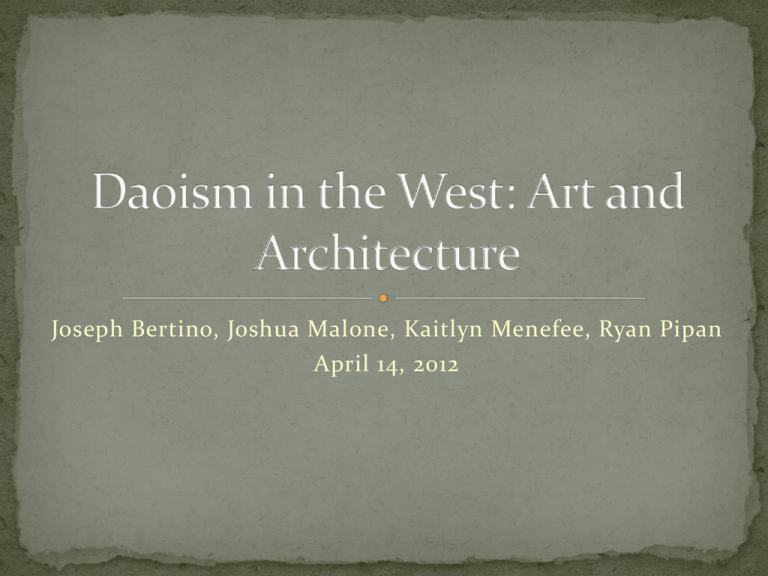
Joseph Bertino, Joshua Malone, Kaitlyn Menefee, Ryan Pipan April 14, 2012 "If our youth seriously listen to such unworthy representation of gods, instead of laughing at them as they ought, hardly willing of them deem that he himself, being but a man, can be dishonored by similar actions- and instead of having any shame or selfcontrol, he will always be whining and lamenting on slight occasions." (Republic 388d) The Painter is therefore three times removed from the truth "The art of imitation is a far cry from the truth. the reason it(the painter) can make everything, apparently, is that it grasps just a little of each thing- and only an image at that... paint us a carpenter, he knows nothing of the man's skill and yet he is a good painter, from a distance his picture of the carpenter can fool children and people with no judgement because it looks like a carpenter" (598b-c). "All in all, then, what people in this situation would take for the truth would be nothing more than the shadows of the manufactured objects" (515c). "Well I imagine that audiences and spectators can take pleasure in beautiful sounds and colors and shapes, and in everything which is created from these elements but that their minds are incapable of seeing and taking pleasure in, the nature of beauty itself" (476b). Uneducated and easily swayed led astray Art should be used for education of great citizens “…to imitate is natural to humans from childhood, so also it is natural for everyone to take pleasure in imitations” (On Poetics 1448b5-10) Often made solely for profit; an ends to a means Void of truth, or underlying meaning Simulacrum Mostly copies, with no originals Only valued for entertainment video games, movies, cartoons To explain or reveal something deeper about the relationship between mankind and the environment Not about profit or utility Illustrate an ultimate truth (the Dao), the secrets of nature Primary goal capture nature’s spirit, rather than imitate its physical characteristics Truly great artists reveal the subject’s inner qualities Energy, movement, essence, spirit qi (the manifestation of Dao) Woodworker Ching’s Bellstand From the Zhuang Zi, “For there to be life, a necessary prerequisite is that it not be separated from the physical form” Blank spaces indicate wu 无 nonaction Focus attention on main subject Allow the viewers mind to wander Often black and white presence, absence Seeing largeness in smallness Man not the center, unlike Old Testament Rivers bend, weave symbol of water Shan Shui “mountain-water” Style of painting emphasizes nature, uses 5 elements, in proper pairs Chinese Element Color Direction 木 mu Wood Green East 火 huo Fire Red South 土 tu Earth Tan/Yellow NE/SW 金 jin Metal White/Gold West/NW 水 shui Water Blue/Black North Too big! Imposes on landscape, susceptible to natural disasters Dominates the environment Depends upon many foreign materials In respect to Daoist principles pertaining to Chinese architecture, a structure is considered an artwork that is lived in Furthermore, the building should leave a place or clearing for truth to reveal itself to its inhabitants Promote positive, orderly human relations This concept is absent in Western architecture due to Le Corbusier’s “Machine Aesthetic Principle” Charles-Edouard Jeannerette “Le Corbusier” Believed architecture had to keep up with the technological advancements of the time Contemporary architects now needed to 1. incorporate industrial technology into buildings such as plumbing and heating systems 2. Have the building’s aesthetics resonate with contemporary technological advancments The architect is now the artist The artist is inspired by the universal laws of nature Coincides with the philosophies of Plato and Aristotle in that there is an abstraction of forms Forms are easily copied Corbu takes an abstraction of these forms into what he calls “the architectural plan” In the 19th Century, businesses wished to maximize production People held responsible for mass production, and are products of mass production Unlike the Daoist conception of architecture, buildings are not necessarily artworks to be lived in. Rather, they are like factories that house human productivity The machine aesthetic of these buildings is easily copied and reproduced Thus the shape and function of the building is replicated from city to city The shape of a building should be based on the intended the purpose and function of the building Corbu believed the plan in drawing up a building is an austere abstraction Form should not be restricted to what form is supposed to do Because the plan is very abstract, the function of the building did not always work out Example the new science center The apparition of these faces in the crowd; Petals on a wet, black bough. -Ezra Pound And God blessed them, and God said unto them, Be fruitful, and multiply, and replenish the earth, and subdue it: and have dominion over the fish of the sea, and over the fowl of the air, and over every living thing that moveth upon the earth. And God said, Behold, I have given you every herb bearing seed, which is upon the face of all the earth, and every tree, in the which is the fruit of a tree yielding seed; to you it shall be for meat. And to every beast of the earth, and to every fowl of the air, and to every thing that creepeth upon the earth, wherein there is life, I have given every green herb for meat: and it was so. -Genesis 1:28-30 Heaven and Earth are not humane. They regard all things as straw dogs. The sage is not humane. He regards all people as straw dogs…. -Dao De Jing, 5 Tao is empty (like a bowl), It may be used but its capacity is never exhausted. It is bottomless, perhaps the ancestor of all things. It blunts sharpness, It unties its tangles. It softens its light. It becomes one with the dusty world…. -Dao De Jing, 4 Building merges with site Form follows function…and nature Nature as model Borrowing Yin/yang Interior/exterior Man-made/natural Space is filled with qi Fengshui Geography, Climate, Aesthetics Cities and Houses Balancing qi from nature with bodily qi Harmony and Flow Superstitious? Practical! (Exploited) Understanding the reciprocal relationships between nature and architecture: High and Low Protruding and Retreating Open and Closed Sunny and Shady Exterior and Interior South and North Scattered and Condensed A and ~A When Man is born, he is tender and weak. At death, he is stiff and hard. All things, the grass as well as trees, are tender and supple while alive. When dead, they are withered and dried. Therefore the stiff and the hard are companions of death. The tender and the weak are companions of life. Therefore if the army is strong, it will not win. If a tree is stiff, it will break. The strong and the great are inferior, while the tender and the weak are superior. -Dao De Jing , 76
